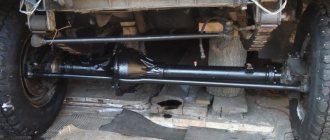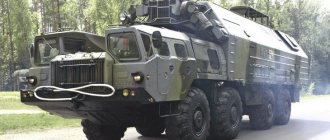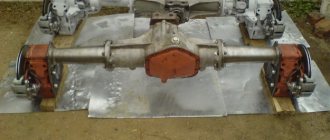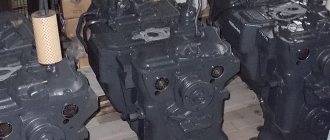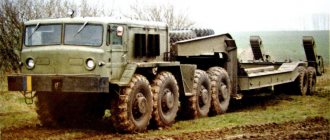Rear axle of the UAZ-469B car
Unlike the UAZ-469, the UAZ-469B is equipped with a rear axle without wheel reduction gears.
The rear axle housing (Fig. 70) is detachable in a vertical plane and consists of two parts connected by bolts.
The rear bearing is pressed onto the end of the drive gear, the end of which is open. To remove the drive gear, you need to separate the crankcase halves and remove the differential and driven gear assembly.
The main gear consists of one pair of bevel gears with a spiral tooth: drive 9 and driven 12. The gear ratio of the main gear is 5.125. The driven gear is mounted on the gearbox and bolted to its flange. The drive gear is mounted on two bearings: on one side - a double bevel (front) 10, on the other - radial, with cylindrical rollers (rear) 4. The drive gear flange is secured with a nut 7. The double bevel bearing is adjusted by spacers 8.
An adjusting ring 5 for the position of the drive gear is installed between the end of the outer ring of the double tapered bearing and the crankcase flange.
Rice. 70. Rear axle of the UAZ-469B car: 1 - safety valve; 2 — differential bearing; 3 and 8 — adjusting shims; 4 — rear bearing of the drive gear; 5 — adjusting ring; 6 - oil removal ring; 7 - nut; 9 - drive gear; 10 — front bearing of the drive gear; 11 — thrust washer of the semi-axial gear; 12 - driven gear.
Between the flange of the drive gear and the double tapered bearing there is an oil removal ring 6.
The differential is conical, with four satellites. The axle gears have replaceable thrust washers 11.
The differential is mounted on two tapered bearings 2. Adjusting shims 3 are installed between the ends of the gearbox and the inner rings of the differential bearings.
Maintenance of the rear axle of the UAZ-469B vehicle and possible malfunctions are the same as for the rear axle of the UAZ-469 vehicle.
As in the rear axle of the UAZ-469, adjust the gaps in the meshing of gears and bearings only when replacing gears and bearings or when noticeable axial play appears in the drive or driven gears of the main gear. Replace the main gears only as a complete set.
Adjust the main gear drive gear bearing by selecting the thickness of the gasket package 8 (Fig. 70) and tightening the nut 7. The bearing must have such a preload that there is no axial movement of the drive gear, and the gear rotates by hand without much effort.
Check the bearing preload with a dynamometer. At the same time, disconnect the left half of the crankcase, the differential case and remove the drive gear bearing cap so that oil seal friction does not affect the dynamometer readings. With proper adjustment, at the moment the drive gear is rotated by the hole in the flange, the dynamometer should show a force of 1.5. 3 kgf for run-in bearings and 2.0. 3.5 kgf for new bearings. The tightening torque of nut 7 securing the drive gear flange should be 17.21 kgf* m. You cannot even unscrew the nut a little in order to ensure that the cotter pin hole coincides with the slot of the nut. If the nut is insufficiently tightened, the inner rings of the bearing may rotate and, as a result, wear of the adjusting shims and the appearance of dangerous axial play.
Technical characteristics of UAZ 469
The technical characteristics of the UAZ 469 are a topic of interest to many, but when starting to talk about them, first of all, you need to understand that this model was produced in several modifications and many of the characteristics differed in them. Therefore, to clarify, let’s first briefly look at the modifications of the UAZ 469.
- UAZ 469 is a classic army version. The main distinguishing features are a two-stage final drive, 300mm ground clearance and so-called military axles.
- UAZ 469B is the most common civilian version with a single-stage final drive. Ground clearance, compared to the military modification, is reduced and amounts to 220mm.
- UAZ 469BI is an analogue of the UAZ 469B, but with shielded electrical equipment.
- UAZ 469G - medical version.
- UAZ 469РХ – designed for radiochemical reconnaissance.
- UAZ 469AP is a police UAZ with a metal roof, additionally equipped with a grille that separates the main cabin from the side seats located in the rear of the car. The back door is barred and has a lock on the outside.
The most common modifications are UAZ 469 and UAZ 469B. We will consider their characteristics in detail in the next article.
Replacing wheelsets
Often standard wheels are not enough to overcome serious off-road conditions. When installing special rubber, the main pair is usually replaced. The characteristics of standard wheelsets are designed specifically for the use of factory tires. If you don't replace the wheelsets when switching to larger wheels, they won't last long.
After replacing the wheelsets, they must be adjusted, which consists of accurately setting the gear play and uniform tightening of the bolts. Adjustment will allow you to avoid rapid wear of parts and other problems with wheelsets.
When installing military bridges, the main thing is to be aware of why you need a car. If it was purchased exclusively for off-road use, then a military bridge is the best solution. For a car that will have to be used frequently on the highway, this is not the best choice.
If you have any questions, leave them in the comments below the article. We or our visitors will be happy to answer them
Overall dimensions of UAZ 469
| UAZ 469 | UAZ 469B | |
| Body type | Steel frame body, open, station wagon | |
| Number of doors | 5 | |
| Number of seats | 7 | |
| Length | 4025 mm. | |
| Width | 1805 mm. | 1785 mm. |
| Height | 2050 mm. | 2015 mm. |
| Base | 2380 mm. | |
| Ground clearance (clearance) | 300 mm. | 220 mm. |
Main technical characteristics of UAZ 469
| UAZ 469 | UAZ 469B | |
| Weight without load | 1600 kg. | 1540 kg. |
| Full load weight | 2400 kg. | 2280 kg. |
| Fuel tank volume | 78 l. | |
| Drive unit | Fully pluggable | |
| Highest speed at full weight | 90 km/h. | 120 km/h. |
| Control fuel consumption at a speed of 30 km/h. | 10.6 liters / 100 km. | |
| Highway range at reference consumption 10.6 l/100 km | 730 km. | |
| Braking distance with full load from an initial speed of 70 km/h | No more than 44.8 meters. | |
| Fording depth | 0.7 meters | |
| Maximum gradeability with driver and 1 passenger | 57 degrees | |
| Maximum gradeability when fully loaded | 31 degrees | |
| Maximum gross weight of towed trailer | 760 kg. | |
Characteristics of the UAZ 469 engine
| Type | Gasoline, 4-stroke |
| Location | Front, longitudinal |
| Cylinder arrangement | Row |
| Number of cylinders | 4 |
| Operating procedure | 1-2-4-3 |
| Cylinder diameter | 92 mm |
| Piston stroke | 92 mm |
| Compression ratio | 6,7 |
| Power | 75 hp |
| Working volume | 2.5 l. |
| Torque | 166.7/2200 n*m |
| Supply system | Carburetor |
| Number of valves per cylinder | 2 |
It’s worth looking in more detail at gasoline consumption: With a reference consumption of 10.6 liters on the highway, the average gasoline consumption of the UAZ 469 is about 10.75/l. 100 km along the highway. And the maximum off-road gasoline consumption is approximately 17.25 liters. At 100 km.
Characteristics of the UAZ 469 transmission, chassis and control systems
Transmission
UAZ 469 is equipped with a 4-speed manual transmission with synchronizers in 3rd and 4th gears. The weight of the gearbox without lubrication is 33.5 kg. Oil volume – 1 l.
Gear ratios: First gear – 4.12 Second gear – 2.64 Third gear – 1.58 Fourth gear – 1.00 Rear gear – 5.22
Transfer case
UAZ 469 is equipped with a 2-speed manual transfer case. It is rigidly attached to the gearbox without an intermediate driveshaft. Its weight including the handbrake is 37.4 kg. The volume of oil to be filled is 0.7 l.
Gear ratios: Direct transmission – 1.00 Low gear – 1.94 Power take-off – up to 40%
UAZ 469B has a single-speed transfer case.
Bridges UAZ 469
One of the basic differences between the UAZ 469 and the UAZ 469B is the bridges. They can be military and collective farm, respectively.
Source
Technical characteristics of the UAZ 469 car
Popular to this day, the domestic jeep
The UAZ 469 all-terrain vehicle, which appeared in our country in the early 70s of the twentieth century, remained for a long time the best domestic SUV. Thanks to its high reliability, maintainability in field conditions and low price, this unpretentious hard worker still remains the standard all-wheel drive vehicle for many.
Indeed, what other car can you fill with a cloudy brownish liquid called A-72 gasoline, used motor oil and castor oil instead of brake fluid, and then drive our entire great country from end to end without ruining the engine and brake system. The technical characteristics of the UAZ 469 are unique; they allow this SUV to be used in conditions that would kill any other vehicle.
The “goat” also has disadvantages, in particular, a tarpaulin awning instead of a normal roof and a weak stove, which make your teeth chatter when traveling in the winter season. But they are more than compensated by the awareness of the fact that along the way you won’t get stuck in a snowdrift and freeze your limbs.
History of creation
Technical characteristics and features of the UAZ-3303 car: we describe all the nuances
Since 1952, the Ulyanovsk Automobile Plant has produced GAZ 69 and GAZ 69A passenger cars. The first modification was intended for the army, and the second for agricultural needs. The only differences were in the design of the interior: the military version had 8 seats, and the civilian version had 5 seats. Both cars were created on the elemental basis of the GAZ M 20 Pobeda model. Possessing good cross-country ability, these cars had several significant drawbacks. Firstly, both modifications did not have interior heaters, which, in our harsh climate, made it difficult to operate the GAZ 69 in the cold season. Secondly, these cars had a GAZ 11 engine, which was incredibly voracious and low-powered. In addition, the military was not pleased with the small ground clearance, only 210 millimeters. In real off-road conditions, the command vehicle sank in the mud where army trucks and armored vehicles were passing. In this regard, already in the mid-50s, the idea of replacing this jeep appeared. In 1958, a prototype of the UAZ 460 was developed, but it never went into production.
In the 60s, the Volga was replaced by the GAZ 21 on the main assembly line of the Gorky Automotive Automotive. Of course, a new SUV was developed on its elemental base; it was supposed to be put on the line already in 1965. But due to a change in the country's leadership, these plans could not be implemented on time. The era of stagnation began. The future UAZ 469 was produced only in experimental batches and waited in the wings for another 7 long years.
Basic characteristics of the body and engine
Brief description of the UAZ 469 (469B):
- body – steel, open;
- type – frame convertible station wagon;
- number of places – 7;
- number of doors – 5;
- length – 4025 mm;
- width – 1805 (1785) mm;
- height – 2050 (2015) mm;
- base – 2380 mm;
- ground clearance – 300 (220) mm;
- weight without load – 1600 (1540) kg;
- weight with full load – 2400 (2280) kg;
- fuel tank volume – 78 liters;
- maximum speed – 90 (120) km/h;
- ford depth – 0.7 m;
- maximum climbable height with driver and 1 passenger – 57°;
- the maximum climbable height at full load is 31°.
Since the start of production, the UMZ 414 engine has been installed on the civilian modification of the SUV.
Military models were equipped with the same power unit, but with a pre-heater, so the motor has a different index - UMZ 41416.
- type – gasoline, atmospheric, 4-stroke;
- number of cylinders – 4;
- arrangement – in-line, vertical;
- operating order – 1-2-4-3;
- cylinder diameter – 92 mm;
- piston stroke – 92 mm;
- engine displacement – 2.5 l;
- compression ratio – 6.7;
- power – 75 l. With.;
- maximum torque – 167 Nm;
- average gasoline consumption on the highway – 10.75 liters per 100 km;
- maximum off-road gasoline consumption – 17.25 liters per 100 km;
- weight of the UMZ 414 engine with attachments and clutch, but without fluids – 163 kg;
- weight of UMZ 41416 with canopies and clutch, but without fluids - 165 kg;
- coolant volume (coolant) – 13 l;
- operating coolant temperature – 80-90°C;
- engine oil volume in the cylinder block – 5.8 l;
- normal oil pressure at idle – 0.5-0.8 kg/cm³;
- normal oil pressure at speed is 2-5 kg/cm³.
Under the hood of the 469 model
DIY gearbox repair
Repairing a final drive is a rather complicated procedure, but if you have certain skills, it can be done independently. First you need to remove the side gear housing itself.
Disassembly of the final drive must be done in a vice. To disassemble the final drive, you need to unscrew the bolts holding the locking plates. Next, you should inspect each bearing for its further operation. If a major overhaul is carried out, each bearing must be replaced.
When carrying out repairs, it is imperative to fill the final drives with new oil. All parts that have chips, cracks and gouges must be replaced. The gear axle shaft must be checked for integrity. If you plan to use it harshly, it is better to install reinforced shafts. The seals also need to be inspected and the faulty seal needs to be replaced.
The final drive must be assembled using a vice. All elements of the assembly are assembled and installed in the final drive housing. The differential is put in place, the bearing caps are screwed on. This completes the gearbox repair.
Features of transmission, chassis and control systems
The unique characteristics of the UAZ 469 are largely due to the successful design of the transmission. This vehicle system consists of a dry single-plate clutch, a gearbox, a transfer case, a rear drive axle, a front axle, and wheel drives for an army modification of an SUV.
Technical characteristics of the gearbox:
- type – 4-speed, mechanical;
- synchronizers - in 3rd and 4th gears.
- 1st gear – 4.12;
- 2nd gear – 2.64;
- 3rd gear – 1.58;
- 4th gear – 1.00;
- reverse gear - 5.22;
- gearbox weight without lubrication – 33.5 kg;
- The volume of oil in the gearbox is 1 liter.
Transfer case specifications: 2-speed, manual.
- direct transmission – 1.00;
- low gear – 1.94;
- power take-off – up to 40%;
- weight with hand brake, without lubrication – 37.4 kg;
- volume of oil poured – 0.7 l.
Cardan transmission – 2-shaft, open.
- front – 2-hinge, combined;
- front shaft weight – 6.9 kg;
- rear – 2-hinged, tubular;
- rear shaft weight – 8.25 kg.
- type – detachable, with gearboxes on all wheels;
- gear ratio - 5.38;
- final drive ratio – 2.77;
- gear ratio of wheel gearboxes – 1.94;
- front axle weight – 140 kg;
- rear axle weight – 121.5 kg;
- the volume of oil poured into each bridge is 1 liter;
- the volume of oil poured into each wheel gearbox is 0.3 liters.
- type – detachable;
- final drive ratio – 5.13;
- front axle weight – 120 kg;
- rear axle weight – 100 kg;
- the volume of oil poured into each bridge is 0.85 l.
You can distinguish military bridges from collective farm ones in the photo by the conical cap on the splined flange and the double final drive.
- suspension - rigid, leaf spring;
- springs – 7-9 leaf, elliptical;
- shock absorbers – telescopic, double-acting;
- wheels – steel, stamped;
- tires - tube;
- The recommended tire size is 215/90 R15.
- mechanism - worm type;
- gear ratio – 20-21;
- volume of oil poured – 0.25 l.
- type – hydraulic, drum;
- parking brake – transmission;
- liquid volume – 0.52 l.
In general, the control systems of the UAZ 469 are reliable and durable.
Share photos and rate photos of other users
We have compiled a selection of videos about the repair and maintenance of UAZ vehicles
Source
History of creation
Since 1952, the Ulyanovsk Automobile Plant has produced GAZ 69 and GAZ 69A passenger cars. The first modification was intended for the army, and the second for agricultural needs. The only differences were in the design of the interior: the military version had 8 seats, and the civilian version had 5 seats. Both cars were created on the elemental basis of the GAZ M 20 Pobeda model. Possessing good cross-country ability, these cars had several significant drawbacks. Firstly, both modifications did not have interior heaters, which, in our harsh climate, made it difficult to operate the GAZ 69 in the cold season. Secondly, these cars had a GAZ 11 engine, which was incredibly voracious and low-powered. In addition, the military was not pleased with the small ground clearance, only 210 millimeters. In real off-road conditions, the command vehicle sank in the mud where army trucks and armored vehicles were passing. In this regard, already in the mid-50s, the idea of replacing this jeep appeared. In 1958, a prototype of the UAZ 460 was developed, but it never went into production.
In the 60s, the Volga was replaced by the GAZ 21 on the main assembly line of the Gorky Automotive Automotive. Of course, a new SUV was developed on its elemental base; it was supposed to be put on the line already in 1965. But due to a change in the country's leadership, these plans could not be implemented on time. The era of stagnation began. The future UAZ 469 was produced only in experimental batches and waited in the wings for another 7 long years.
